'Fire Emblem: Three Houses' is a slice of epic life
The school setting evolves the Fire Emblem formula in all the right ways.
This article contains no story details, beyond those revealed in the game's official trailers. There is discussion of some mechanics and procedural details yet to be shown by Nintendo.
Fire Emblem: Three Houses is the game Fates should have been.
Developer Intelligent Systems has made a lot of tweaks to its formula for the series' first outing on the Nintendo Switch, and the result of those changes is a game that marries Fire Emblem's dual personalities in a meaningful and satisfying way.
If you don't know about Fire Emblem already, a quick primer: It's an almost-three-decade-old tactical RPG franchise from Japan that only came to the West after characters like Roy appeared in Super Smash Bros. Melee on the GameCube. It didn't truly rise to worldwide prominence until the release of Awakening on the 3DS in 2012.
Fire Emblem games are epic fantasy tales about nobles, knights and mages, often spanning years. While the series has always had grand, turn-based battles, it's increasingly focused on the relationships between the myriad characters fighting in them. Three Houses follows this path, too, but with the move from 3DS to Switch, it does so in a more accomplished, natural way. Now, what happens between conflicts is just as important as the battles themselves.
Three Houses is set in Fódlan, a continent split into a trio of nations controlled by noble bloodlines. In the center of Fódlan is a monastery that plays home to the Church of Seiros, the region's main religion. And in that monastery is an officer's academy where each nation's best and brightest are sent to learn about knighthood. This school is segregated, so students from each nation go into their own class.
The setup is somewhat similar to Fates, but your role in the story is very different. As the game begins, the academy happens to be inducting the future leaders of each country. Your character (who can be male or female) is a new professor at this school and must choose one of the three houses, and therefore future leaders, to teach. Your decision affects how the story will unfold and which characters you will end up fighting alongside.
Once you've made your decision, things settle into the routine of everyday school life, but it's not long before strange things start occurring. The story then shifts towards the twists and turns Fire Emblem games are known for, and you begin taking your students into increasingly challenging battles.
Goodbye, weapon triangle
In Three Houses, sword does not beat ax, ax does not beat lance and lance does not beat sword. This rock-paper-scissors system has been a huge part of Fire Emblem combat, and while this isn't the first Fire Emblem game to drop it -- see Gaiden in '92 and its recent remake Shadows of Valentia -- it is still likely to be a contentious decision.
In place of the triangle, characters learn combat arts as they study and fight. You'll find a sword art that's effective against beasts, an ax art that smashes through armor and a bow art that increases your range. These special attacks come at a cost: Fire Emblem weapons usually degrade by a point per attack, but utilizing an art can reduce durability by as much as five points.
There is actually still some hidden weapon triangle stuff going on -- advanced lance users unlock the "swordbreaker" skill that makes those duels more favorable, and so on -- but it just doesn't play as big a part in combat as it used to. Instead of just putting my ax user in sight of a lance-wielding enemy, I had to devise a strategy and use terrain to my advantage.
After initial doubts, I'm all for the change. The shift to exploiting class weaknesses over "what weapon is this enemy carrying" also makes a lot of sense. It's mirroring the status quo for bows and flyer class enemies, and how class-effective weapons (which make a return) work. With that said, playing the game at normal difficulty was not particularly challenging. There's a mechanic that lets you rewind turns if you make an error, and I generally felt overleveled for a lot of missions. I usually ignore the "this mode is for experienced players" advice that games give, but this time I wish I hadn't.
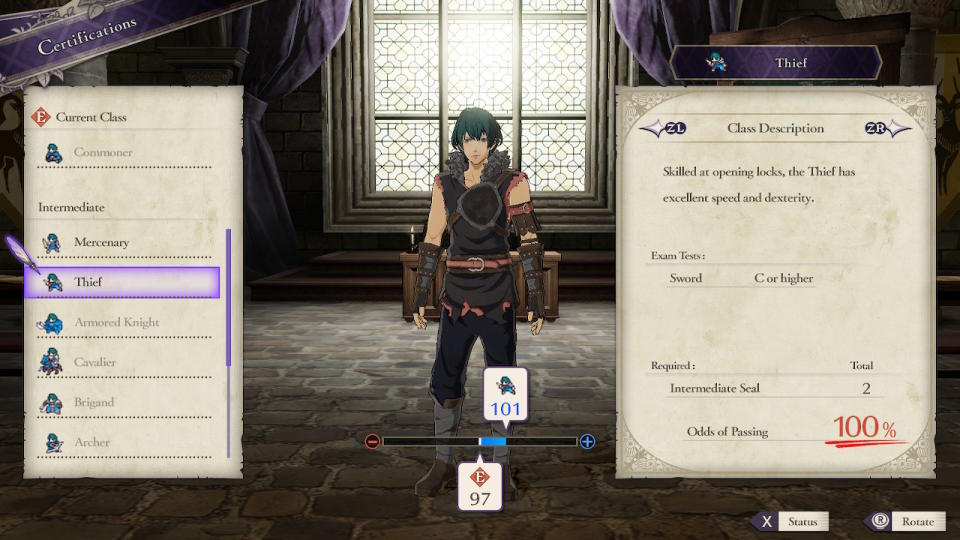
Another thing worth mentioning is re-classing. As your students level up, you'll have them take certification exams to change class from, for example, a soldier to pegasus knight. To pass exams, a student needs to be proficient enough in the relevant skills. This is similar to old games, but the new bit is students can be certified in multiple classes at any time, and you can then select which class a character enters a battle as.
There is no limit to how many classes your character can be certified in, besides the fact that time is limited, so there are only so many skills you'll be able to level up sufficiently to pass exams. The flexibility is nice, especially later in the game when your needs may shift.
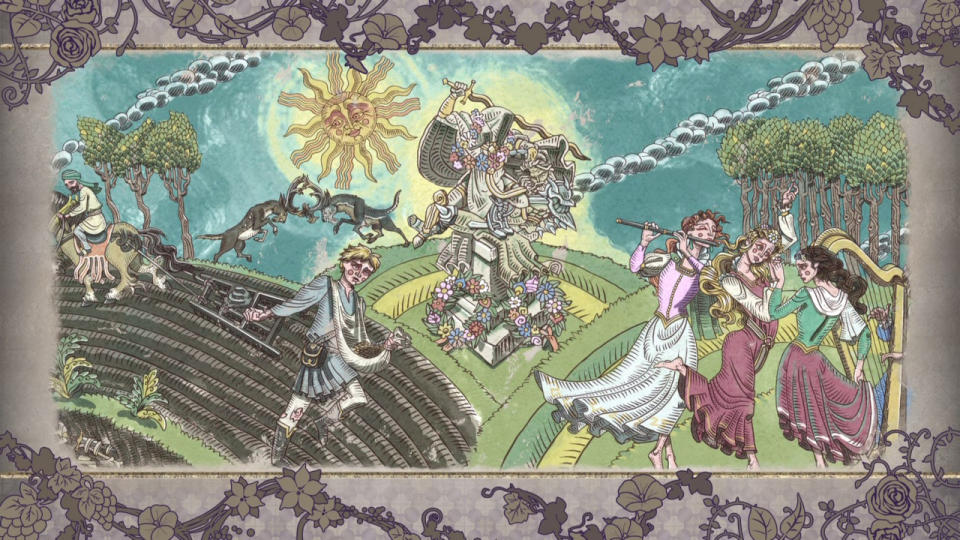
Fire Emblem games are generally divided into parts and chapters, further establishing the epic fantasy theme. Each chapter has some story development and a large battle, in which you control a number of units and attempt to outmaneuver your enemy. Three Houses keeps that conceit, but structures it around a calendar. Months begin with a medievalesque tableau, with a narrator telling you the month's significance to the religious year. This may seem like window-dressing, but it's an effective way to set the tone and build out the larger world.
The calendar is also crucial to the gameplay loop. You still have a big unavoidable battle each month, but beyond that there's a new weekly cadence to events.
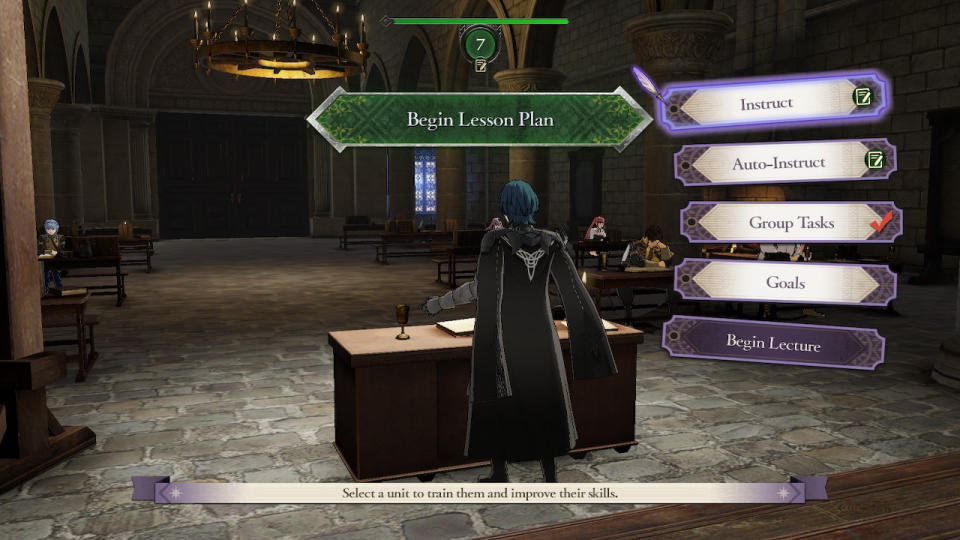
Each Monday, you create a lesson plan in the service of improving your students' skills. The more motivated your students at the start of the lesson, the more they'll learn. Barring some story beats, teaching takes up your Monday to Saturday, and then there's Sunday. This is called free time, but in reality it's anything but. Sunday is your opportunity to do pretty much everything. Each week you make a choice: battle, rest, seminar or explore.
In battle, you take your students into either a training mission or a story-driven side quest, known in Fire Emblem parlance as a Paralogue. Rest is also self-explanatory: relax and boost all of your students' motivation level by 50 percent. Seminar has a member of staff at the academy teach a few of your students about their specialty. This raises the corresponding stats, and also boosts motivation, but does nothing for those not attending the seminar. Then, finally, there's explore, which is the best thing about Three Houses.
The big screen
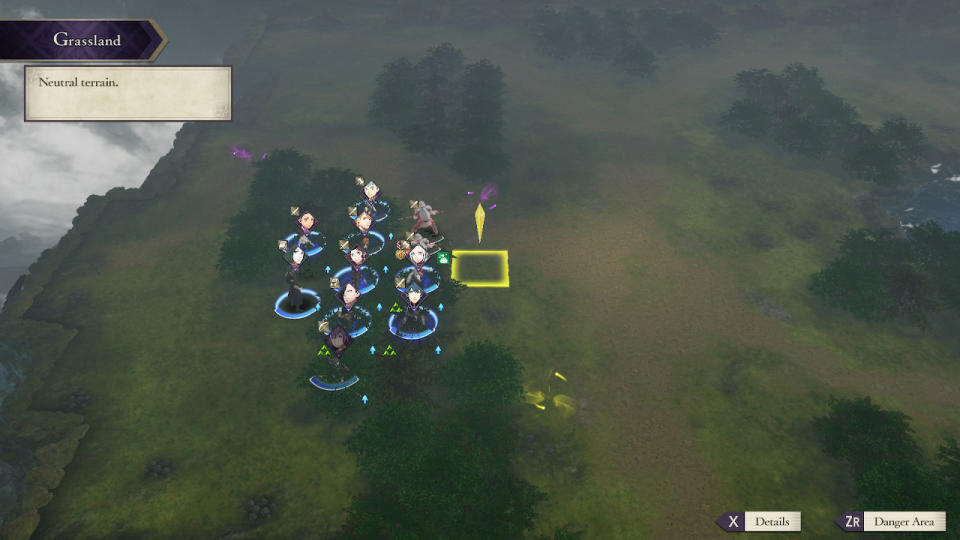
After years exclusively on underpowered DS systems, Fire Emblem on a big screen is suitably epic.
The art style is like a 3D anime, and it's a welcome change from the crusty polygonal bodies of Awakening and Fates. While I don't care to count pixels, the game can get a bit fuzzy at times, but coming from the 240p presentations on the 3DS, it's a huge improvement. The 2D artwork -- the anime cut scenes, the face cards next to dialogue boxes and especially the title cards for each month -- is also superb.
Another area of improvement is sound. Every line of support dialogue is spoken aloud, and the battle music is fantastic. There's a nice amount of variation to the backing tracks -- things even get a bit wub-wubby in one of the later missions -- but if you don't love rousing orchestral music you might be in for a bad time.
With that said, there are some teething problems with the move to the Switch. Cutscenes seem to be encoded at 24 frames per second, i.e. a different frame rate to the game. This frame-rate mismatch leads to a lot of judder in the otherwise excellent clips, which is especially noticeable during slow camera pans, and on a large TV.
That's a nitpick, to be sure, but a more impactful issue is the in-battle camera. It's good for the most part, but I wish it showed more of the battlefield. There's a handful of camera zoom levels to pick from, but even the most distant (see above) wasn't zoomed out enough for me once the maps ballooned in size.

Explore mode, then, is where it all happens. You wander the monastery advancing the story, tightening support bonds and improving your students' motivation.
Support is a key part of what makes Fire Emblem tick. When your characters fight next to each other, they bond and improve their support rank, which in turn provides stat boosts in battle. Ranking up is also a catalyst for support conversations -- little slice-of-life stories that explore the personalities and motivations of the characters. Three Houses still has that battle-based system, but the majority of the support improvements and conversations in my play-through took place in explore mode.
Everything you do at the monastery divides into activities and free actions. Each week, you're given activity points (the number raises as you progress) that you spend in a number of ways. You can get instruction from another staff member, have a student take part in a tournament, share a meal, sing in the choir, invite one of your students to tea (this final one triggers a mini-game I found creepy, but admittedly less so than petting) and so on. There will always be more possible activities than you have points for.
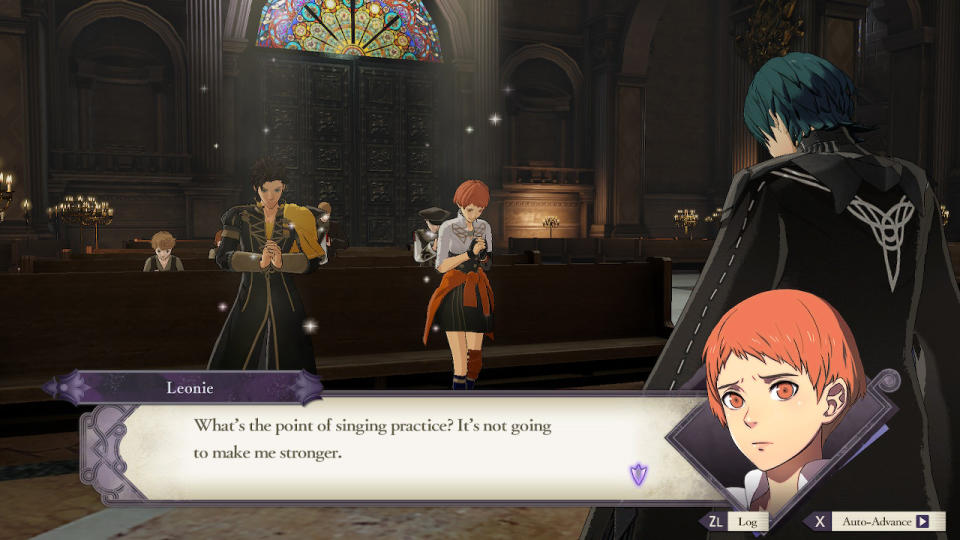
Then there are the free actions. Things like growing plants in the greenhouse, repairing statues, shopping, exploring the grounds for items and a pretty nifty fishing mini-game. The main draw, though, is the entire school of people to get to know. There are dozens of characters -- students and staff alike -- to talk to, almost all of whom you can befriend, no matter their house affiliation. Sometimes you'll get a little soundbite, sometimes a full conversation with dialogue choices, and as things progress, people will begin discussing the storyline that's unfolding. The diverse cast of characters really makes the monastery feel alive.

Building rapport is important. It improves your support rank with people, and you can also talk to people from other houses into temporarily joining you for your next battle or, if you are knowledgeable in their favorite subjects, defecting and joining your class permanently. I only achieved this once in my play-through, and it wasn't that great as I already had similar units on my team. If I'd actually done some research and targeted someone useful, rather than wandering around giving flowers to everyone, this might have been a real boon in later battles.
While you're exploring, characters will offer you quests to complete inside explore mode. These can drive the story forward -- for example, "please go and look into mysterious goings-on at the chapel" -- or be as meaningless as "help me find this thing for a reward." (Side note: People lose their belongings so often at this school that you're given an entirely separate inventory called "lost items".) Occasionally you'll get a quest in the explore mode that unlocks a mission in next week's battle menu.
The explore mechanic feels like a natural evolution for the series.
Perhaps knowing that some fans might not appreciate this more gentle and admittedly time-consuming exploration, Intelligent Systems has built in some quality-of-life workarounds. To avoid wandering aimlessly, you can fast-travel to locations or characters, and there are traditional menus for buying, selling or repairing things. If you did nothing but menus and fast travel, Three Houses would probably feel a lot closer to a traditional Fire Emblem game. Problem is, you'd just be missing out on a lot of the scene setting, incidental moments and character building that push this game beyond those that came before it.
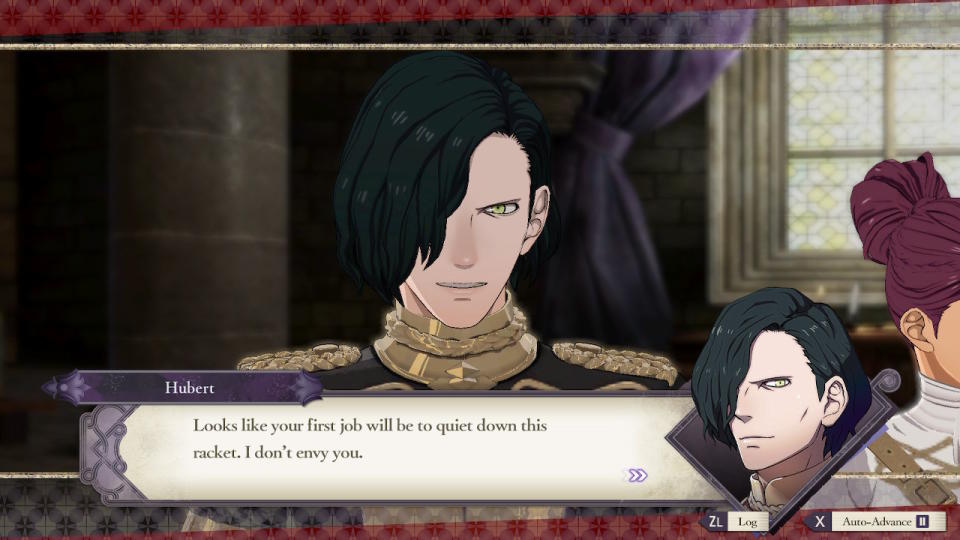
All told, the explore mechanics feel like a natural evolution for the series. Yes, it's a little like playing fantasy Persona 5 at times, but the addition of activity points actually improves on that formula for me. While you can't do everything, you don't have to pick just one task. The net result is you end each free period feeling like a well-rounded human, as opposed to someone that's spent all their time romancing an age-inappropriate doctor.
Three Houses also gets its work-life balance right in a way that Persona games never quite have. You talk to and spend time with people, which boosts support bonds and motivation for lessons, which advances character development and improves your performance in battles. It's an impactful, addictive and ultimately very comforting loop.
Online and Amiibo
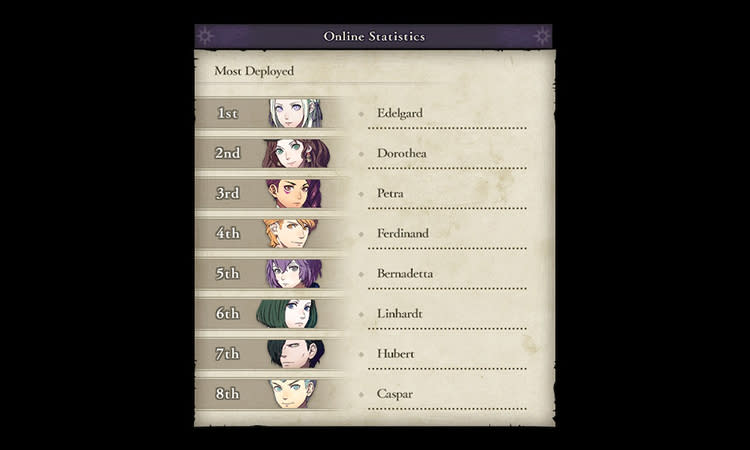
Three Houses has some light online integrations. When deciding what to do each week, you'll see percentages next to each choice indicating the most popular actions. Loading screens similarly throw up charts showing you the world's most-used units. Unfortunately, these weren't particularly effective given the game isn't out yet.
There's also a feature where distant players can send a representative of sorts into your game, and vice versa. I used this mechanic to put a rare fish up for sale to anyone interested, but, again, the player-pool is so small that no one took me up on the offer. Or perhaps my fish just wasn't enticing enough.
The last of the new tricks is Amiibo support, in the form of the Amiibo gazebo. Visiting this location in the monastery and touching an Amiibo to your controller will cause random items to spawn, with more interesting pieces reserved for Fire Emblem-specific figurines. None of these items are game-breaking in a pay-to-win sense -- more often than not you'll pick up a blend for a tea party or some seeds to grow in the greenhouse.
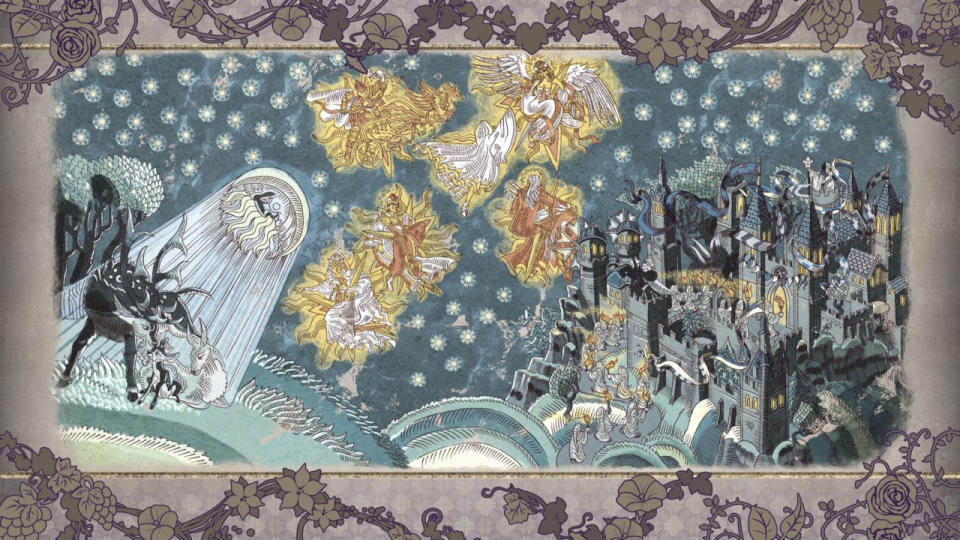
Explore mode would not work if the game wasn't written well. It is.
The terms of Nintendo's embargo forbid me talking about the story beyond a major flashpoint around ten hours in, and I wouldn't want to spoil it anyway. What I will say is Three Houses has some great twists and turns.
The more recent trailers gave away that there's a time skip in this game, which is a shame as keeping that under wraps would've been amazing. Either way, major characters do some wild things, and you should go in expecting to make decisions that completely change how you experience the story.
Where Fates often felt rushed, Three Houses takes its time. If you get to know the characters properly through the explore system, every decision they make is mostly logical, even when you don't see a twist coming. The story did lose the thread a bit as it approached its conclusion, but maybe that was a quirk of my play-through and the decisions I'd made.
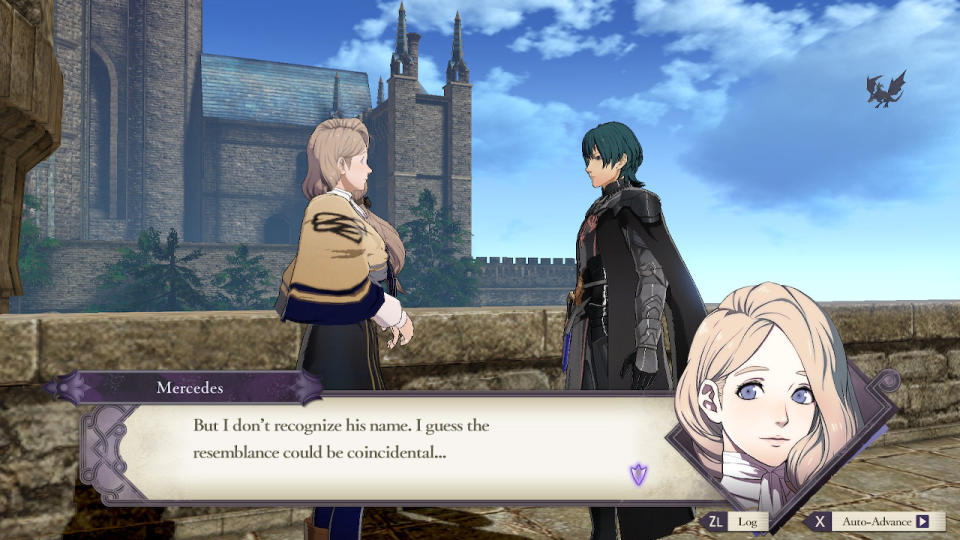
Beyond the main plot, the incidental dialogue is well-written, and the fully voiced support stories are entertaining. One downside of this new-found freedom was a couple of slightly tone-deaf scenes, most likely because the game expected me to get to know the character earlier than I did. (They involved talking about a dead person as though they were still alive.)
That aside, characters in my chosen house offered comedy, tragedy and everything in between. There are the expected anime and Fire Emblem tropes, of course, but all students have some degree of depth and motivating factors that explain why they are the way they are.
It says a lot that the first thing I did when I finished Three Houses was start over. The game warns you if a choice majorly impacts on the plot, which means I know that I've only experienced one side to the story. And that's just the tale of one house.
The first thing I did when I finished 'Three Houses' was start over.
While the other houses were present in my play through, there are apparently two different stories that I missed out on: According to Intelligent Systems, the experience of playing with each faction is unique. I'm around two hours into my New Game+ now, and I've selected a different house. Even before anything major has happened plot-wise, my new students are less uptight than the last batch, and their response to adversity feels different.
Although I need to crack on with the other houses to see how much they differ, the pitch here is that you're getting three games in one, rather than paying for one game three times, as you did with Fates and its Birthright, Conquest and Revelation skews. With its three paths, the breadth of content on offer here is staggering: Intelligent Systems says a complete play through (i.e. all three houses, side quests and support conversations) will take around 200 hours.
Given you're probably not going to be rushing through this massive game in four days like me, that 200-hour figure will likely ring true for you. The first house storyline took me around 45 hours to finish, and I imagine the next two will be closer to 60. Then I need to go back and make some different decisions with the first house. And maybe the other two, if they're as divergent as the first? (Pro tip: Use multiple save slots to guarantee you can revisit those big decisions. I did not do this, so will have to start from scratch.)
In case it wasn't clear, it's going to be a Herculean task to see everything Three Houses has to offer. Thank goodness it's so much fun.
Fire Emblem: Three Houses will be available on Nintendo Switch July 26th.
